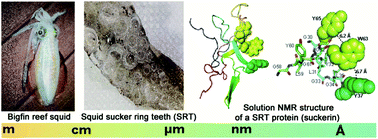Supramolecular propensity of suckerin proteins is driven by β-sheets and aromatic interactions as revealed by solution NMR†
Abstract
Suckerin proteins are a family of block co-polymer-like structural proteins that self-assemble into robust supramolecular structures – the sucker ring teeth (SRT) – which are located on the arms and tentacles of cephalopods and used to firmly capture preys. Suckerins are promising biomimetic protein-based biopolymers, but the supramolecular interactions stabilizing SRT remain unknown. Here, we report multi-dimensional Nuclear Magnetic Resonance (NMR) spectroscopy structural studies of an engineered suckerin protein composed of two main sequence modules. The protein adopts a dynamic structure with regions in both module 1 (M1: residues A42–A52) and module 2 (M2: residues G30–Y37 and G58–Y65) folding into anti-parallel β-sheets and displaying β-strand propensity, respectively. The obtained structure highlights that aromatic residues present in glycine (Gly)-rich M2 modules are involved in π–π stacking interactions, leading to the stabilization of the structural core. In addition, hydrogen/deuterium (H/D) exchange studies demonstrate a high protection of residues involved in intra-molecular β-sheets. Gaining a better understanding of the molecular structure of suckerin provides key molecular lessons that may be mimicked in the de novo design of peptide- and protein-based biomaterials with applications in medicine, tissue engineering and nanotechnology.



 Please wait while we load your content...
Please wait while we load your content...